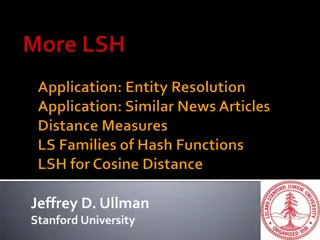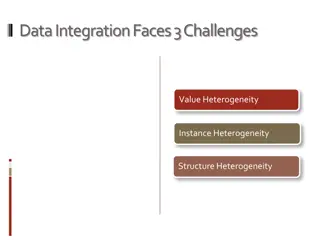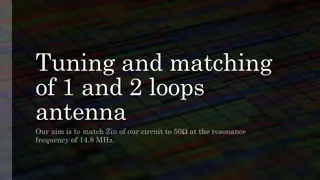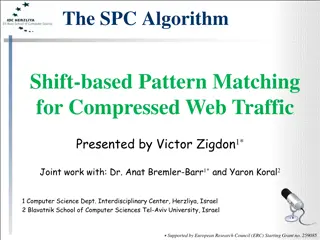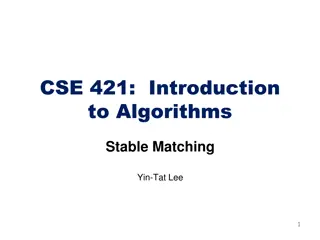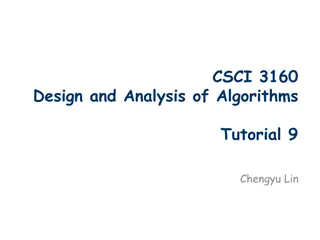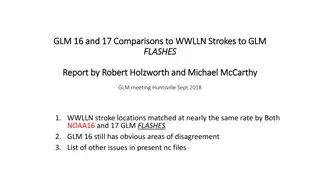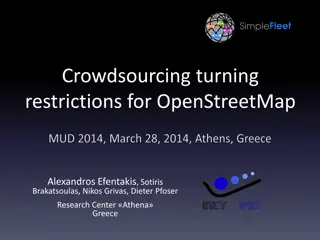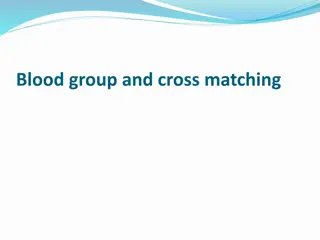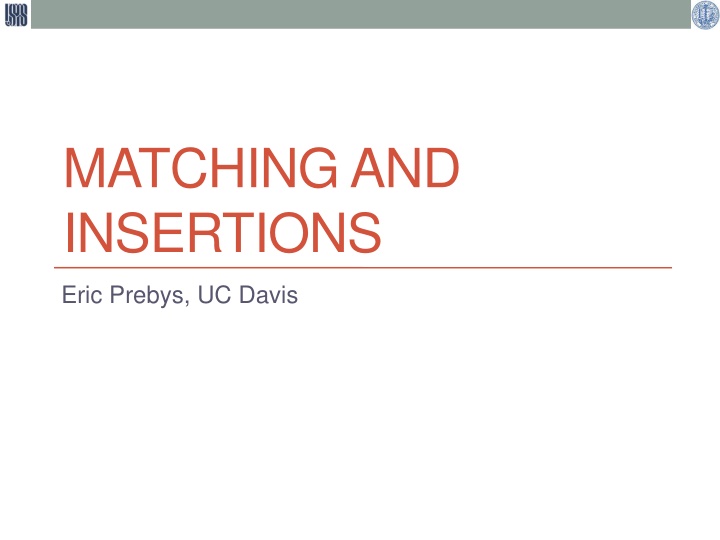
Accelerator Fundamentals: Matching and Insertions in Synchrotron Design
Explore the concepts of matching and insertions in accelerator design, focusing on the challenges and solutions for incorporating straight sections and optimizing lattice functions. Learn about Collins Insertions and the importance of ensuring regular lattice functions are maintained throughout the design.
Download Presentation

Please find below an Image/Link to download the presentation.
The content on the website is provided AS IS for your information and personal use only. It may not be sold, licensed, or shared on other websites without obtaining consent from the author. If you encounter any issues during the download, it is possible that the publisher has removed the file from their server.
You are allowed to download the files provided on this website for personal or commercial use, subject to the condition that they are used lawfully. All files are the property of their respective owners.
The content on the website is provided AS IS for your information and personal use only. It may not be sold, licensed, or shared on other websites without obtaining consent from the author.
E N D
Presentation Transcript
MATCHING AND INSERTIONS Eric Prebys, UC Davis
2 USPAS Fundamentals, June 4-15, 2018 E. Prebys, Accelerator Fundamentals: Matching and Insertions The Problem So far, we have talked about a synchrotron made out of identical FODO cells, with the space between the quads taken up by bend dipoles. The problem is that this is not particularly useful, because there s no place to put beam in or take it out, and no way to collide beams. One solutions is to design a straight into every cell. Example: the Fermilab Booster x24 However, this is very wasteful of real estate. It would not be practical for the LHC.
3 USPAS Fundamentals, June 4-15, 2018 E. Prebys, Accelerator Fundamentals: Matching and Insertions Insertions Since putting a empty straight section in every period is not practical, we need to explicitly accommodate the following in our design: Locations for injection of extraction. Straight sections for RF, instrumentation, etc Low beta points for collisions Since we generally think of these as taking the place of things in our lattice, we call them insertions FODO FODO FODO Insertion FODO FODO FODO Match lattice functions
4 USPAS Fundamentals, June 4-15, 2018 E. Prebys, Accelerator Fundamentals: Matching and Insertions Mismatch and Beta Beating Simply modifying a section of the lattice without matching will result in a distortion of the lattice functions around the ring (sometimes called beta beating) Here s an example of increasing the drift space in one FODO cell from 5 to 7.5 m
5 USPAS Fundamentals, June 4-15, 2018 E. Prebys, Accelerator Fundamentals: Matching and Insertions Collins Insertion A Collins Insertion is a way of using two quads to put a straight section into a FODO lattice 1s 1s 2s f f f f f f f f F F L L L 4 4 , , m m m Where s2 is the usable straight region
6 USPAS Fundamentals, June 4-15, 2018 E. Prebys, Accelerator Fundamentals: Matching and Insertions Require that the lattice functions at both ends of the insertion match the regular lattice functions at those point F sin 1 0 1 0 1 1 1 s 1 s 1 s 1 1 1 1 2 1 = M 1 1 0 0 0 F + sin cos sin sin I m I m I = cos m I I m I Where Iis a free parameter After a bit of algebra 2 tan I 2 sin = = = ; ; I s s F 1 2 Maximize s2 with I= /2, max (which is why we locate it L/2 from quad) Works in both planes if x=- y (true for simple FODO)
7 USPAS Fundamentals, June 4-15, 2018 E. Prebys, Accelerator Fundamentals: Matching and Insertions Dispersion Mismatch The problem with the Collins insertion is that it does not match dispersion, so just sticking it in the lattice will lead to distortions in the dispersion Collins Insertion
8 USPAS Fundamentals, June 4-15, 2018 E. Prebys, Accelerator Fundamentals: Matching and Insertions Dispersion There is no way to bend a beam in a curved path without introducing dispersion. There are three cases dispersion is desirable: To be used in combination with sextupoles to introduce chromaticity adjustment To be used in combination with a collimation system to eliminate particles which are too far away from the nominal momentum. Used in conjunction with various types of cooling to reduce energy spread. In all other cases, dispersion is a problem Makes the beam bigger than it needs to be Introduces problematic energy/position correlation
9 USPAS Fundamentals, June 4-15, 2018 E. Prebys, Accelerator Fundamentals: Matching and Insertions Dispersion Suppression Recall that dispersion propagates as Dx(s) D'x(s) 1 d(s) d'(s) 1 Dx(0) D'x(0) 1 m11 m21 0 m12 m22 0 = For a straight section, d(s)=d (s)=0, but dispersion will still propagate unless D(0)=D (0)=0 is also true. Dispersion Suppression
10 USPAS Fundamentals, June 4-15, 2018 E. Prebys, Accelerator Fundamentals: Matching and Insertions Dispersion Suppression (cont d) On common technique is called the missing magnet scheme, in which the FODO cells on either side of the straight section are operated with two different bending dipoles and a half-strength quad Straight section Mirror image 1 1 2 2 f f f f f f f 2 Recall that the dispersion matrix for a FODO half cell is (lecture 4) 1-L2 2L 1+L 1-L2 2Lq 1+L 4 f-L2 1 Lq 2 q 1 Lq 2 q 1 2 f2 2f 4 f 1 1 L L 1 1 0 1 1 f 0 1 0 1 1 0 2 f2+L2 0 -1 2 f 0 -1 2 f 0 L 2q 1-L M= = - 1 0 0 0 1 0 1 0 0 0 1 0 1 0 4 f3 2 f2 0 8 f2 0 1 0 1 0 1
11 USPAS Fundamentals, June 4-15, 2018 E. Prebys, Accelerator Fundamentals: Matching and Insertions So we solve for 0 D m ( ) ( M ) m = = = M 0 D 2 1 1 1 Where Dm and D m are the dispersion functions at the end of a normal cell (for a simple lattice, D m=0) We get the surprisingly simple result 1 1 = = 1 ; 1 2 2 2 4 sin 4 sin 2 2
12 USPAS Fundamentals, June 4-15, 2018 E. Prebys, Accelerator Fundamentals: Matching and Insertions Missing Magnet Cofiguration If we look at our solution 1 1 = = 1 ; 1 2 2 2 4 sin 4 sin 2 2 And consider the case =60 , we get = = 0 1 2 So the cell next to the insertion is normal, and the next one has no magnets, hence the name missing magnet .
13 USPAS Fundamentals, June 4-15, 2018 E. Prebys, Accelerator Fundamentals: Matching and Insertions Combining Insertions Because the Collins Insertion has no bend magnets, it cannot generate dispersion if there is none there to begin with, so if we put a Collins Insertion inside of a dispersion suppressor, we match both dispersion and the lattice functions.
14 USPAS Fundamentals, June 4-15, 2018 E. Prebys, Accelerator Fundamentals: Matching and Insertions Low Insertions In a collider, we will want to focus the beam in both planes as small as possible. This can be done with a symmetric pair of focusing triplets, matched to the lattice functions (dispersion suppression is assumed) Symmetric FODO FODO FODO FODO triplet triplet FODO FODO FODO FODO Dispersion suppression 0 Dispersion suppression = = * ; Recall that in a drift, evolves as 2 s = + = + 2 * ( ) 2 s s s 0 0 0 * Where s is measured from the location of the waist
15 USPAS Fundamentals, June 4-15, 2018 E. Prebys, Accelerator Fundamentals: Matching and Insertions Phase Advance of a Low Beta Insertion We can calculate the phase advance of the insertion as 2 / 2 / 1 L L L L ds ds L = = = 1 2 tan * * 2 s / 2 / 2 + 1 * -I For L>> *, this is about , so cosm+asinm -gsinm bsinm cosm-asinm M= ? ? ( ) ( ) ( ) m11m22+m12m21 -2m11m12 ( -m11m21 ( m21 -m12m22 ( m22 a(L/2) b(L/2) g(L/2) a(-L/2) b(-L/2) g(-L/2) a(-L/2) b(-L/2) g(-L/2) ) ) ) ) ( ) ) = I 2 2 m11 m12 ( ( -2m21m22 2 2 ? ? ? Matching guaranteed if insertion is symmetric!
16 USPAS Fundamentals, June 4-15, 2018 E. Prebys, Accelerator Fundamentals: Matching and Insertions Optics Near Low- Insertion 2 s = + * ( ) s * small * means large (aperture) at focusing triplet s
17 USPAS Fundamentals, June 4-15, 2018 E. Prebys, Accelerator Fundamentals: Matching and Insertions Putting the Pieces Together So now we see that in general, a synchrotron will contain A series of identical FODO cells in most of the ring. Straight sections, with modified cells on either end. Dispersion suppression before and after these straight sections If it s a collider, it will also contain One or more low beta insertions with dispersion suppression on either side. The beta function will be very large on either side of the low beta point
18 USPAS Fundamentals, June 4-15, 2018 E. Prebys, Accelerator Fundamentals: Matching and Insertions Example: LHC Recall the LHC layout Superperiodicity of 8 Need insertions for two low beta collision regions (ATLAS, CMS) Two higher beta collision regions (ALICE, LHCb), which double as injections points. Other straights for RF cavities, beam extraction, etc.
19 USPAS Fundamentals, June 4-15, 2018 E. Prebys, Accelerator Fundamentals: Matching and Insertions LHC Optics (out of date) Injection straights/higher collisions Low collisions Dispersion Suppression
20 USPAS Fundamentals, June 4-15, 2018 E. Prebys, Accelerator Fundamentals: Matching and Insertions Beam Line Issues Beam lines are typically built in discrete sections: Matching (to a source, injection point, or extraction point) Transport: The FODO cells we ve been talking about Bends Designed as achromats to suppress dispersion! Focus (or waist ) Uses quad triplet to minimize beta in both planes Collimation sections 90 apart in phase space to clean up 2D phase space
21 USPAS Fundamentals, June 4-15, 2018 E. Prebys, Accelerator Fundamentals: Matching and Insertions Final Focus Triplet As we saw, our normal FODO cell has maxima in one plane where the minima are in the other. For targets or collisions, we want small beta functions in both planes. This optical problem can be solved with a triplet Middle quad ~twice the strength of outer quads (HW problem for next week) Transfer Matrices and Periodic Focusing Systems the triplet are illustrated in Figure 8.8. An exact treatment (using the trigonometric-hyperbolic forms of the transfer matrices) shows that the exit displacements are identical in both planes for equal entrance displacements. The power series expansions [Eqs. (8.7) and (8.8)] can be used to show that the exit angles are approximately equal. When the calculation is carried out, it is found that all terms of order mutually cancel from the total matrix. The following result holds for ( l)2 both the FDF and DFD combinations: 1 2l . (8.38) Ctriplet 2l3/6 1 l)4 Equation (8.38) is accurate to order ( . 8.5 FOCUSING IN A THIN-LENS ARRAY As an introduction to periodic focusing, we shall study the thin-lens array illustrated in Figure 8.9. Orbits in this geometry can be determined easily. The focusing cell boundaries can have any location as long as they define a periodic collection of identical elements. We will take the boundary at the exit of a lens. A focusing cell consists of a drift space followed by a lens, as shown in Figure 8.9. The goal is to determine the positions and angles of particle orbits at cell boundaries. The following equations describe the evolution of the orbit parameters traveling through the focusing cell labeled (n+1) in the series [see Eqs. (8.10) and (8.11)]. The subscript n denotes the orbit 179
22 USPAS Fundamentals, June 4-15, 2018 E. Prebys, Accelerator Fundamentals: Matching and Insertions Dispersion Suppression Any bend section will introduce dispersion. After the bend, it will propagate as Dx(s) D'x(s) 1 0 0 1 Dx(0) D'x(0) 1 m11 m21 0 m12 m22 0 = It will never go away unless we explicitly suppress it in the design
23 USPAS Fundamentals, June 4-15, 2018 E. Prebys, Accelerator Fundamentals: Matching and Insertions Dispersion due to a Dipole We already solved for the dispersion introduced by a bend dipole Dout D'out 1 Lq 2 q 1 1 L Din D'in 1 = 0 1 0 0 ? ? So if the beam line has no dispersion going into the dipole, it will exit with dispersion D=1 2Lq ? ? D'=q
24 USPAS Fundamentals, June 4-15, 2018 E. Prebys, Accelerator Fundamentals: Matching and Insertions Propagation of Dispersion In the absence of additional bends, the beam the dispersion will propagate just like any other orbit. b(s) b0 ( ) cosDy+a0sinDy b0b(s)sinDy 0 1 2Lq q 1 D(s) D'(s) 1 = b0 b(s) ( ) 1 ( )cosDy- 1+a0a(s) ( )sinDy ( ) 0 a0-a(s) cosDy-a(s)sinDy b0b(s) 0 0 1 ? ? ?Dy=np We ll consider the special case of If, in addition, we make the line symmetric, so the lattice functions are the same at the end as the beginning, this simply reduces to 1 2Lq q 1 1 2Lq q 1 (-1)n 0 0 D(s) D'(s) 1 0 0 0 1 = =(-1)n (-1)n 0 ? ?
25 USPAS Fundamentals, June 4-15, 2018 E. Prebys, Accelerator Fundamentals: Matching and Insertions Canceling Dispersion If we put a second magnet at the end of this line, it will modify the dispersion as Lq2 2 q2 1 (-1)nLq 1 0 Dout D'out 1 2 = (-1)nq 1 0 1 0 0 ? ? So we can cancel the dispersion by setting ? ?q2=(-1)n-1q and the dispersion will remain zero until the next bend magnet Such a section of beam line is referred to as an achromat
26 USPAS Fundamentals, June 4-15, 2018 E. Prebys, Accelerator Fundamentals: Matching and Insertions Achromats If the line has 360 of phase advance, we can cancel dispersion with an opposite sign dipole dogleg achromat If the line has 180 of phase advance, we can cancel dispersion with a same sign dipole double-bend achromat Can be incorporated into rings
27 USPAS Fundamentals, June 4-15, 2018 E. Prebys, Accelerator Fundamentals: Matching and Insertions Example: Mu2e Proton Beam Muon production target triplet collimator weird magnet requirement achromat Bend Common Extinction Final? Focus matching Courtesy? Eliana? Gianfelice-Wendt?

